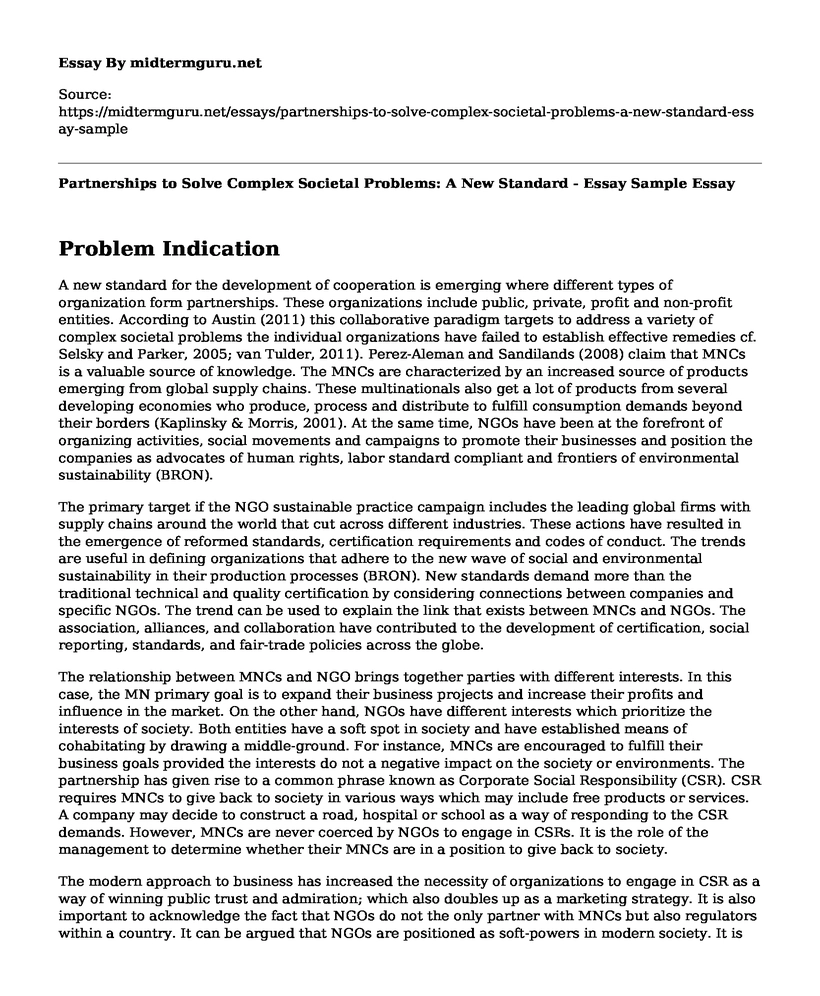Problem Indication
A new standard for the development of cooperation is emerging where different types of organization form partnerships. These organizations include public, private, profit and non-profit entities. According to Austin (2011) this collaborative paradigm targets to address a variety of complex societal problems the individual organizations have failed to establish effective remedies cf. Selsky and Parker, 2005; van Tulder, 2011). Perez-Aleman and Sandilands (2008) claim that MNCs is a valuable source of knowledge. The MNCs are characterized by an increased source of products emerging from global supply chains. These multinationals also get a lot of products from several developing economies who produce, process and distribute to fulfill consumption demands beyond their borders (Kaplinsky & Morris, 2001). At the same time, NGOs have been at the forefront of organizing activities, social movements and campaigns to promote their businesses and position the companies as advocates of human rights, labor standard compliant and frontiers of environmental sustainability (BRON).
The primary target if the NGO sustainable practice campaign includes the leading global firms with supply chains around the world that cut across different industries. These actions have resulted in the emergence of reformed standards, certification requirements and codes of conduct. The trends are useful in defining organizations that adhere to the new wave of social and environmental sustainability in their production processes (BRON). New standards demand more than the traditional technical and quality certification by considering connections between companies and specific NGOs. The trend can be used to explain the link that exists between MNCs and NGOs. The association, alliances, and collaboration have contributed to the development of certification, social reporting, standards, and fair-trade policies across the globe.
The relationship between MNCs and NGO brings together parties with different interests. In this case, the MN primary goal is to expand their business projects and increase their profits and influence in the market. On the other hand, NGOs have different interests which prioritize the interests of society. Both entities have a soft spot in society and have established means of cohabitating by drawing a middle-ground. For instance, MNCs are encouraged to fulfill their business goals provided the interests do not a negative impact on the society or environments. The partnership has given rise to a common phrase known as Corporate Social Responsibility (CSR). CSR requires MNCs to give back to society in various ways which may include free products or services. A company may decide to construct a road, hospital or school as a way of responding to the CSR demands. However, MNCs are never coerced by NGOs to engage in CSRs. It is the role of the management to determine whether their MNCs are in a position to give back to society.
The modern approach to business has increased the necessity of organizations to engage in CSR as a way of winning public trust and admiration; which also doubles up as a marketing strategy. It is also important to acknowledge the fact that NGOs do not the only partner with MNCs but also regulators within a country. It can be argued that NGOs are positioned as soft-powers in modern society. It is essential to dissect this area and establish the actual influence of the MNC-NGO partnership. Therefore, this study will focus on the influence of corporate NGO-partnerships on the commitment of MNC's CSR-strategy. This will be achieved by conducting a case study in high tech manufacturing firms.
References
Austin, J.E. (2000). The collaboration challenge: How non-profits and businesses succeed through strategic alliances. San Francisco: Jossey-Bass Inc Pub.
Bernard, H. Russell. (1988). Research Methods in Cultural Anthropology. Newbury Park, California: Sage
Kaplinsky, Raphael & Morris, Mike. (2001). A Handbook for Value Chain Research. 113. https://link.springer.com/content/pdf/10.1007%2Fs10551-009-0191-0.pdf
Kolk, A., Van Tulder, R., & Kostwinder, E. (2008). Business and Partnerships for Development. European Management Journal, 26 (4). p262-273.
OECD (2006). Evaluating the effectiveness and the efficiency of partnerships, Workshop on evaluating the effectiveness and efficiency of partnerships. Paris: OECD Environment Directorate, ENV/EPOC(2006)15.
Patton, M. Q. (2005). Qualitative Research. Encyclopedia of Statistics in Behavioral Science. https://www.rsm.nl/fileadmin/Images_NEW/Faculty_Research/Partnership_Resource_Centre/Key_publications/the_state_of_partnerships_report_2011_-_ngos.pdf
Perez-Aleman, P., & Sandilands, M. (2008). Building Value at the Top and the Bottom of the Global Supply Chain: MNC-NGO Partnerships. California Management Review, 51(1). p24-49.
Saunders, M., Lewis, P., & Thornhill, A. (2016). Research methods for business students. Harlow: Pearson.
Sekaran, U., & Bougie, R. (2016). Research methods for business: A skill-building approach. John Wiley & Sons Ltd.
Selsky, J.W. & Parker, B. (2005). 'Cross-sector partnerships to address social issues: challenges to theory and practice. Journal of Management. 31 (6). p849-873.
Cite this page
Partnerships to Solve Complex Societal Problems: A New Standard - Essay Sample. (2023, Jan 27). Retrieved from https://midtermguru.com/essays/partnerships-to-solve-complex-societal-problems-a-new-standard-essay-sample
If you are the original author of this essay and no longer wish to have it published on the midtermguru.com website, please click below to request its removal:
- Role and Purpose of Clinical Supervision - Paper Example
- Employees Stock Options - Paper Example on Finance
- Strategic Urbanization of Information Systems and Planning - Research Paper
- Plan for Hiring - Essay Sample
- Recruitment and Selection in Human Resource Management Decision Making - Essay Sample
- Intern at Guards Polo Club: Managing Payrolls, Staff, Vendors & More - Essay Sample
- Preparing for the Global Challenge: National Competitors in the US - Essay Sample







